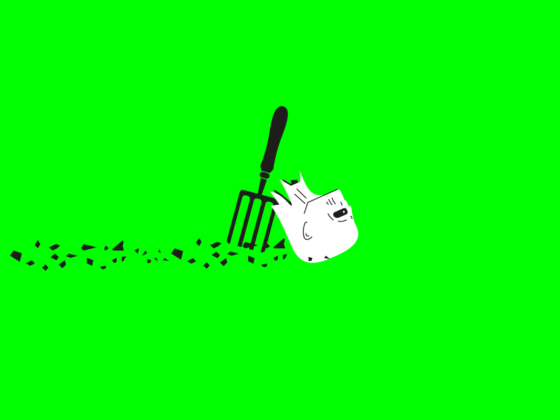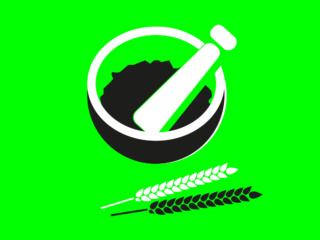Knowing how to grow lamb’s lettuce – aka corn salad – means never running short of vitamins C and A. Or, oBVS, of salad

As a rule, we keep quiet on the subject of lettuce. For two reasons. The first is one of resources: most cultivated varieties of lettuce (cos, romaine, oak-leaf, whatever) need a lot of water, and demand that you spend megawatts of energy keeping slugs off them. The second is nutrition. An iceberg lettuce is basically water and cellulose, making it about as nutritionally useful as cardboard — and with much the same taste. Add the fact that most lettuces are warm-weather crops that won’t store longer than a few days, and you can see why a zombie gardener will have better things to grow.
Ah, but step forward lamb’s lettuce. These rounded, dark green and sweet-tasting leaves grow in pretty much any soil, at any time of year, without you having to do much more than wave hello when you’re passing. And, extraordinarily, slugs aren’t that interested in it — or at least not if there’s anything else green in the vicinity. Granted, it doesn’t adore hot weather, and midsummer sowings tend to throw up their hands and set seed; but it is as frost-hardy as a Russian foot-soldier. Given just a little bit of protection from cloche hoops or a bit of horticultural fleece, lamb’s lettuce stays green and healthy throughout all the but the hardest winter. This means you can keep picking late summer sowings for salad all winter long.
So, how much to sow? Eleven plants will give you an average of 100g of leaves1, (about the same size as the salad bags sold by supermarkets), which is enough to provide a day’s GDR of Vitamin C, and 1.5 days’-worth of Vitamin A.2 Seeing as you can pack 60 plants into a square metre of ground, you can see why we always try to include lamb’s lettuce in a zombie garden. It’s in the neutral rotation group, too, so can follow pretty much anything: we often put it in ground that’s just been vacated by over-wintered chard, early crops of carrots or spring onions, early sprouting broccoli, broad beans or maincrop potatoes.
Sowing and planting
For late spring and early summer crops, sow once in early March and again two weeks later, in 2.5cm-cell module trays, 2 seeds to a module, 1cm deep. Cover and keep at 120C until germination (7-14 days). Thin to one seedling per module, and grow on for three weeks somewhere cool and bright. Harden off as soon as the roots have reached the bottom of the cells (otherwise stress caused b lack of growing space will cause the young plants to bolt and make flowers, not leaves. Plant out 10cms apart in rows 15cms apart, in a site that’s partly shaded in high summer. Mulch well to avoid their shallow roots drying out and the leaves succumbing to powdery mildew.
For autumn crops, sow fortnightly from early July, direct into pre-watered drills 1cm deep and 30cm apart, one seed every 2cms. (Lambs lettuce tends to germinate slowly in hot weather, so be patient.) Thin to 7cms apart. The plants will stand all but the fiercest freezes, but a putting a cloche or a double layer of fleece over them will encourage them to start growing away again a little earlier in the new year.
Aftercare
Don’t bother with feeding, lamb’s lettuce is unlikely to need it unless the soil is very poor. Water lightly but steadily in spring, summer and during dry spells in autumn. Don’t water in winter.
Harvesting and seed-saving
Six weeks or so after planting out, begin to pick whole heads, or take a few leaves from each plant. Winter plants are best harvested whole between October to the end of February, after which any still in the ground will start to put on new leaves and can handle the cut and come again approach. As for saving your own seed: leave a few plants to flower, ad they’ll likely self-seed so widely that DIY-seed collection is barely necessary. But if you insist: grow a batch of 20 or so in May or June, and they’ll bolt very quickly, making low clusters of minute, five-petalled white flowers. Once these have formed their fluffy white seed heads, cut off, and shake the heads (hard!) inside a pillow case or a plastic bag to release the seed. Separate the seed from the feathery bits of chaff by rubbing across a fine-meshed garden sieve, so that the chaff breaks up and falls through, leaving the round, grey seeds behind. Seed should last up to three years.
Main enemies
Powdery mildew is sometimes a problem if the soil is dry but the air is damp: pick off affected leaves and step up your watering. That’s it. Hooray!
Container growing
Like most salad crops, lambs lettuce is a winner in pots — but unlike with cos, iceberg or oak-leaf lettuces, you won’t have to worry so much about slugs and snails, or watering it every five minutes. Containers can be very shallow, too – as little as 10cms of depth will be enough, and some zombie gardeners have had great success sowing lamb’s lettuce in old mushroom trays. Sow seed direct into a 1:1 mix of topsoil and peat-free compost, and thin to five plants per 35cm square of container. Keep high summer pots somewhere lightly shaded and, if you’re using terracotta pots for winter crops, insulate with bubblewrap or fleece to stop them freezing and cracking.
At which point there is not much more to do than remember how, before the apocalypse, you used to spend loads of money on bags of chlorine-washed water-and-cellulose which you never ate — and have a little laugh.

1 Based on average yields from our own garden
2 Based on USDA Food Composition Databases for 100g cornsalad, raw









